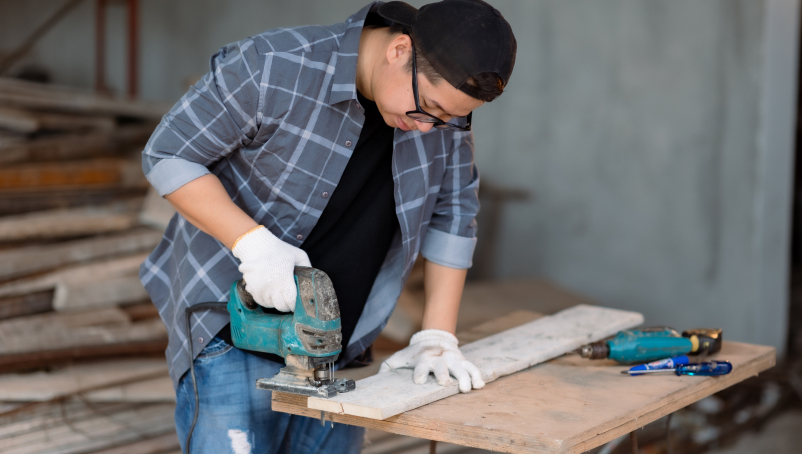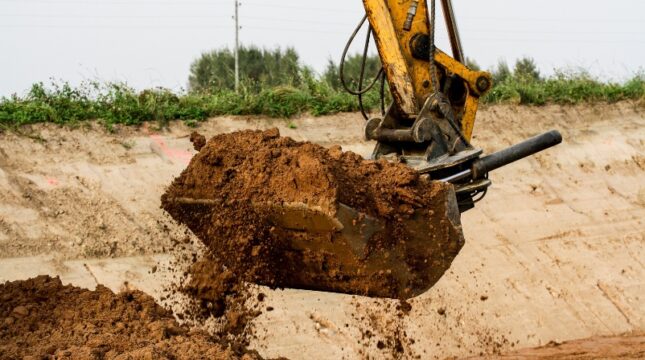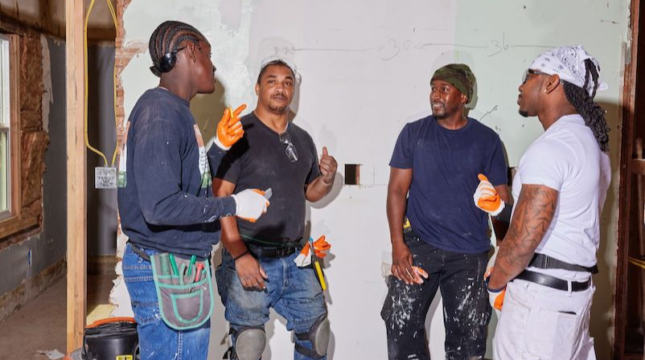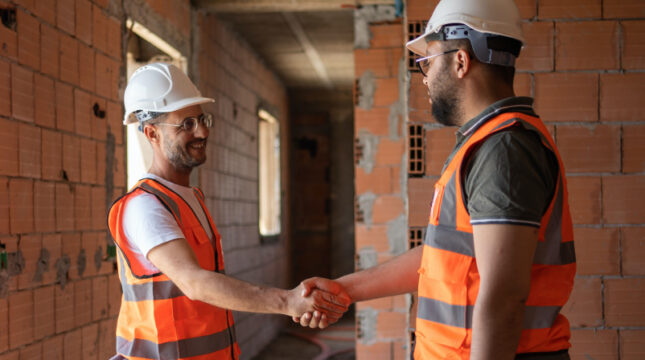Proper clothing and gear
Before you even turn on your saw, you’ll want to make sure you’re appropriately outfitted for this work.
1. Wear proper eye protection
Always wear protective goggles with side shields to protect your eyes from flying debris. Sawdust, wood chips or concrete particles can cause serious eye injuries. For masonry or metal-cutting tasks, upgrading to a face shield can offer additional protection from sparks and fragments.
2. Wear closed-toe, slip-resistant work boots
Proper footwear is a must on any job site, especially when operating powered hand tools. Protecting your feet is just as critical as shielding your hands and eyes.
Closed-toe, steel-toe boots offer protection from dropped saws or materials. Slip-resistant soles help keep your footing secure even in slippery or uneven conditions.
Tips for material handling
As important as it is to prepare your blade for cutting, you’ll also want to prepare your material.
3. Secure the material before cutting
Make sure that whatever you’re cutting is firmly secured to a stable surface. This prevents the material from shifting, which could result in uneven cuts or even cause the saw to slip.
Clamps are an effective way to keep wood or other materials in place, allowing you to focus on precision and safety.
4. Check the material for nails or imperfections
Before cutting, inspect the material for embedded nails, screws or other foreign objects that could damage the blade or cause kickback. This is particularly important when repurposing wood or working on older structures.
Running a metal detector over wood can help avoid these hidden hazards.
Best practices for blades
Improper blade care and/or usage can lead to dangerous kickback (when your tool jerks and kicks back towards you) or binding (when wood is trapped between a rotating blade and a stationary object).
5. Always direct the blade away from your body
When cutting, ensure the blade is always moving away from you. This reduces the risk of injury if the saw slips or kickback occurs.
Kickback is one of the most common dangers when using power saws, and directing the blade away from your body adds an extra layer of safety.
6. Make sure the blade is sharp before each use
A dull blade is inefficient and also more dangerous. It increases the chance of kickback or binding.
Take a few minutes before each job to check blade sharpness and change it if necessary. A sharp blade cuts cleanly, reducing strain on both the tool and the operator.
7. Always keep the blade guard in place
The blade guard is your first line of defense. It should automatically cover the blade when not cutting.
Never wedge, lower or alter the blade guard in any way. Ensuring it is fully functional and in position keeps you safe from accidental contact with the blade.
8. Set the blade depth correctly
Set the blade depth to only extend about 1/8 to 1/4 inch below the workpiece. A blade set too deep increases the likelihood of binding and kickback.
Setting the blade depth appropriately also helps prevent unnecessary wear and minimizes the chance of cutting into underlying structures or supports.
Cutting to avoid kickback
When it’s finally time to put that saw to work, make sure you’re using the right tool for the job.
9. Cut in straight lines — avoid angular or curved cuts
Powered hand saws are designed for straight cuts. Attempting to make angular or curved cuts can cause the saw to bind, leading to dangerous kickbacks.
If your project requires curved cuts, use a jigsaw or another specialized tool designed for that purpose.
Considerations for construction business insurance
Beyond taking safety precautions when using your powered hand saw, there are other ways to help protect yourself — and your business — from risk. Having the proper insurance coverage is key.
10. Help protect your business with the right small business coverage
Another way to proactively help protect yourself, your employees and your business is to ensure that you have the right construction business insurance coverage.
Construction insurance is usually required before you get started on work for your clients. And it can help you save money if there’s an accident involving your business.
Construction liability insurance can help protect your business from some of the most common construction claims by helping pay for damaged property, client injuries or any work mistakes you may be accused of causing at a job site.
Many construction businesses start with general liability coverage that can help cover costs if you or any of your employees are accused of damaging property or causing an injury.
Then, construction businesses add on other types of coverage to increase protection for other types of incidents. For example, you may want to consider:





